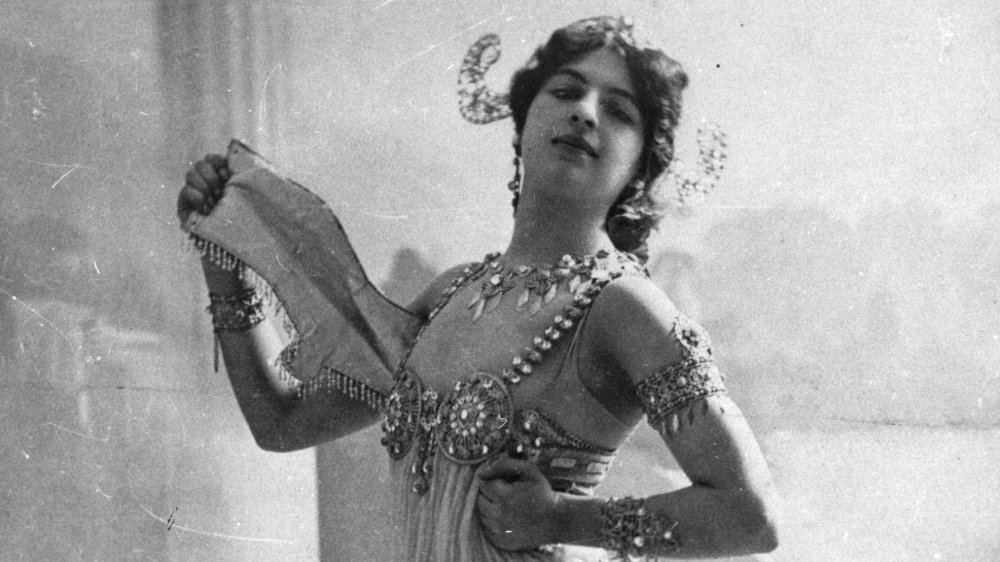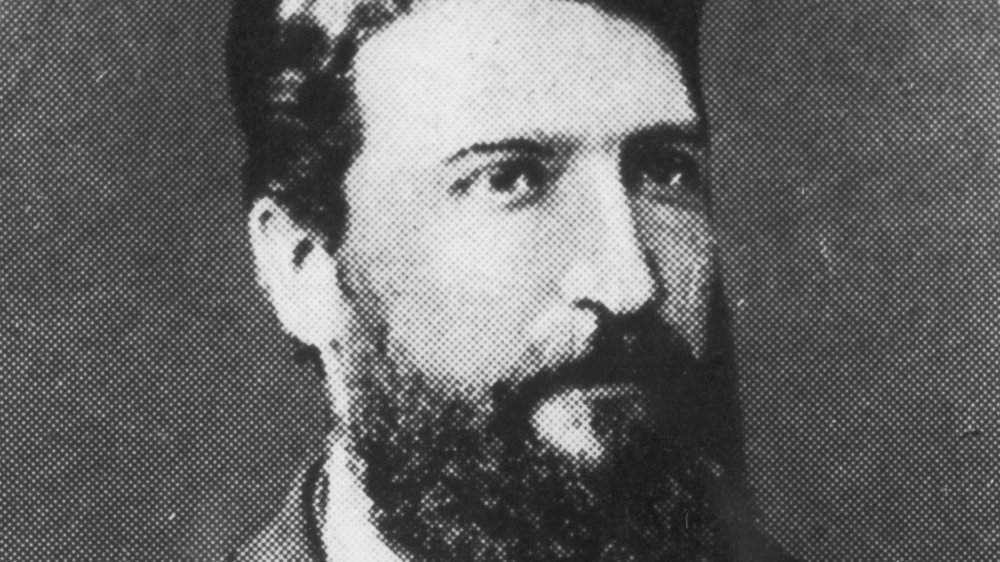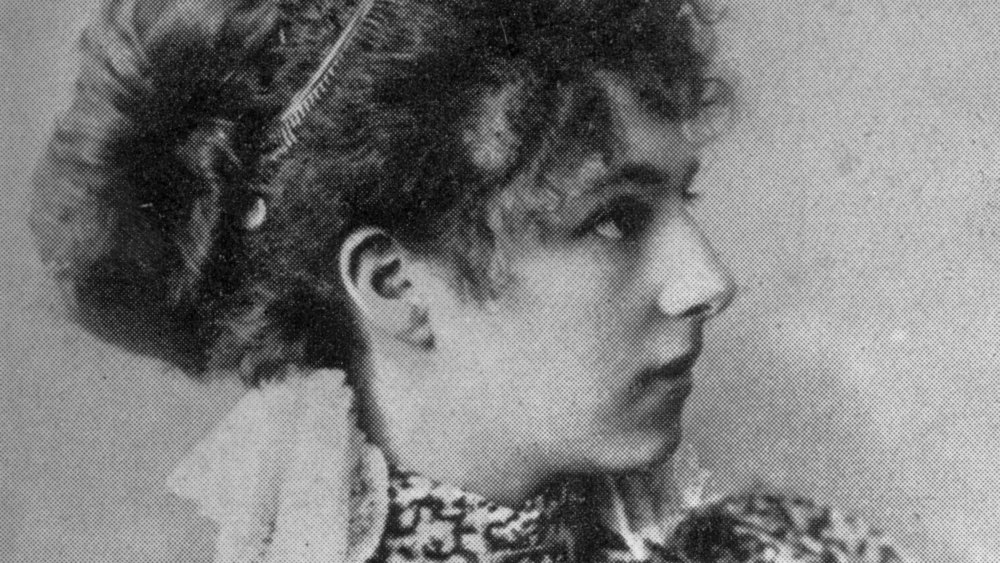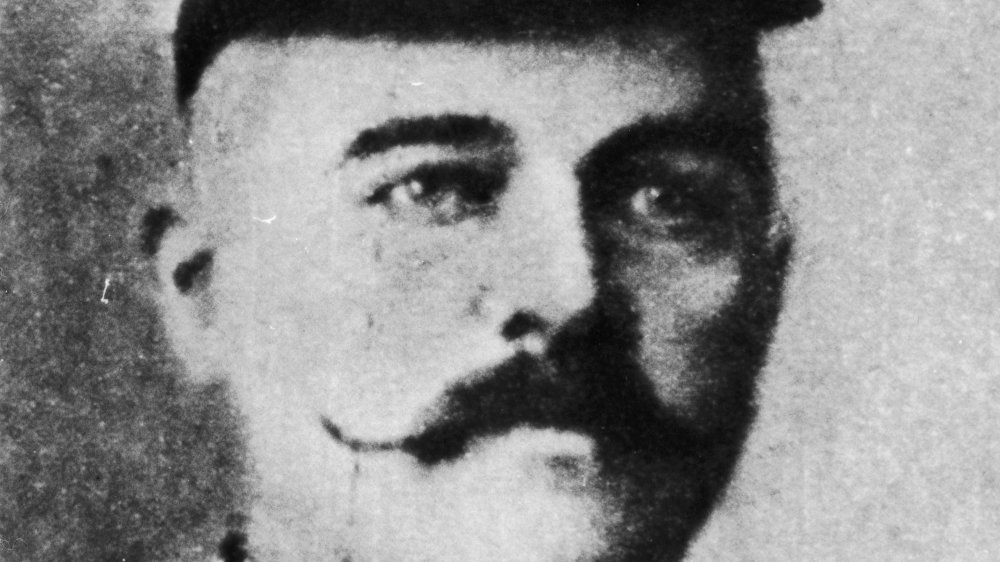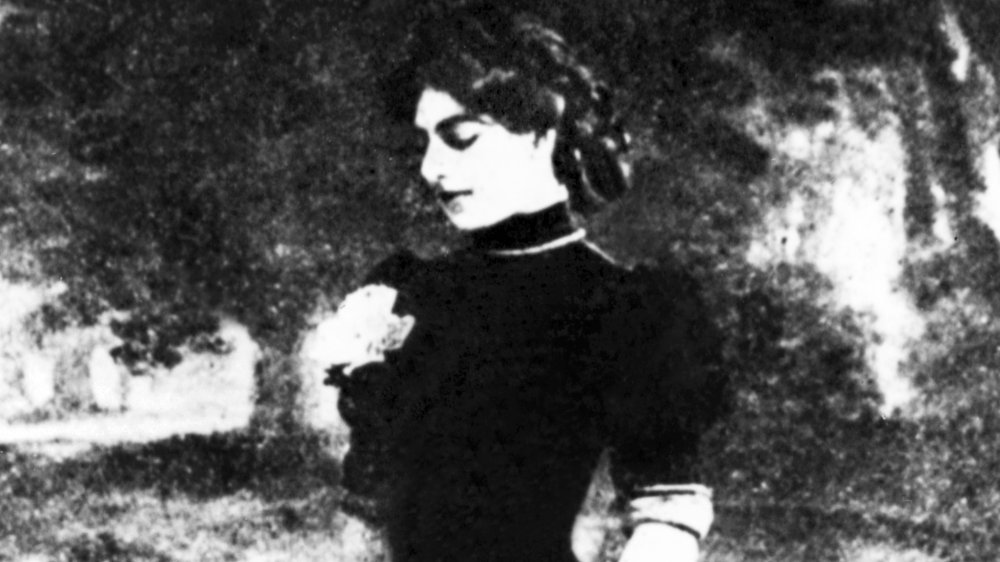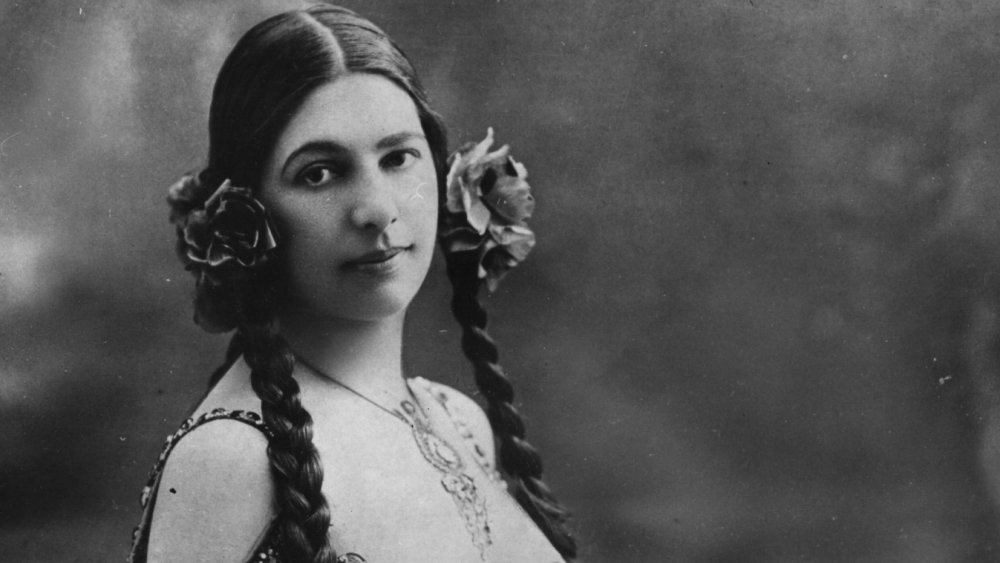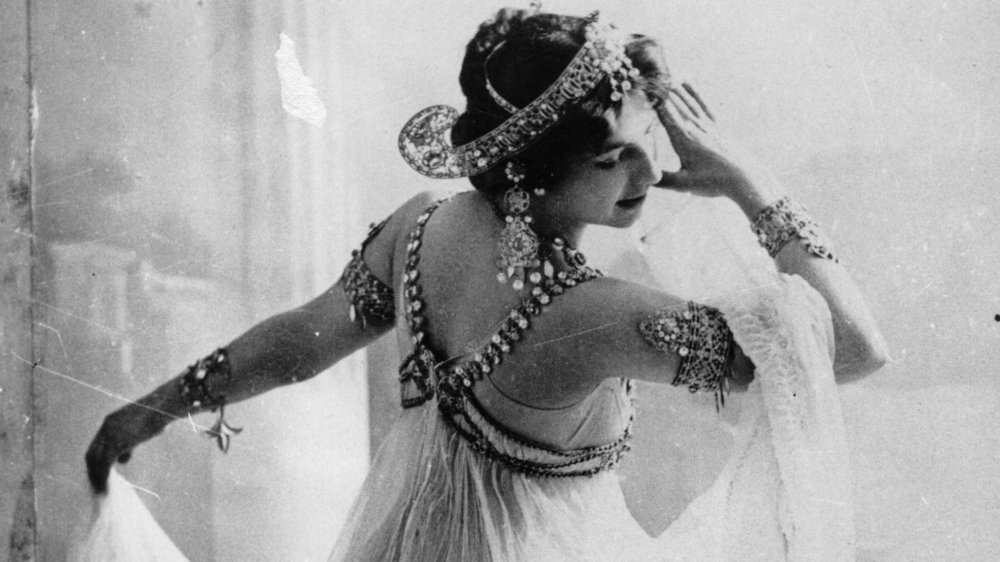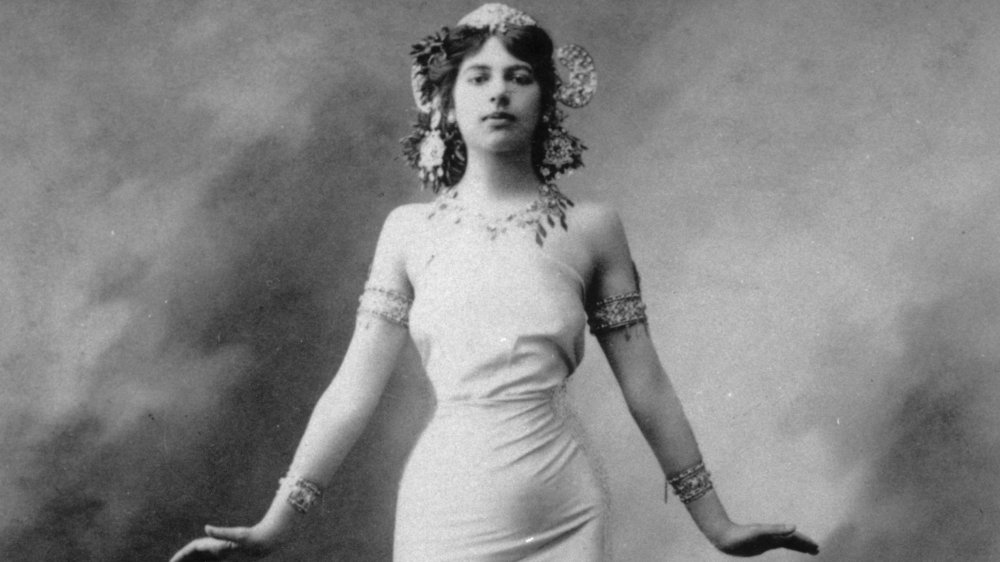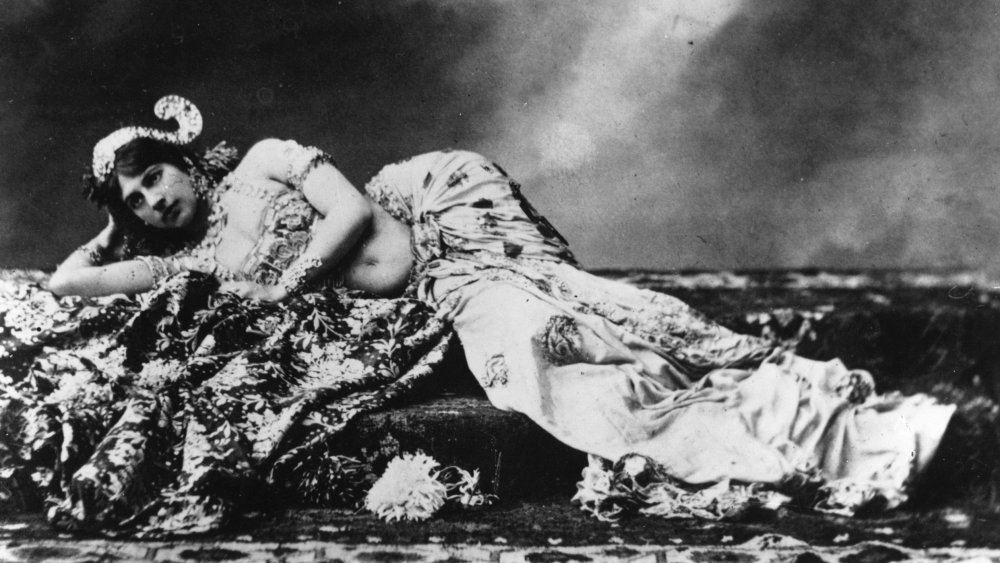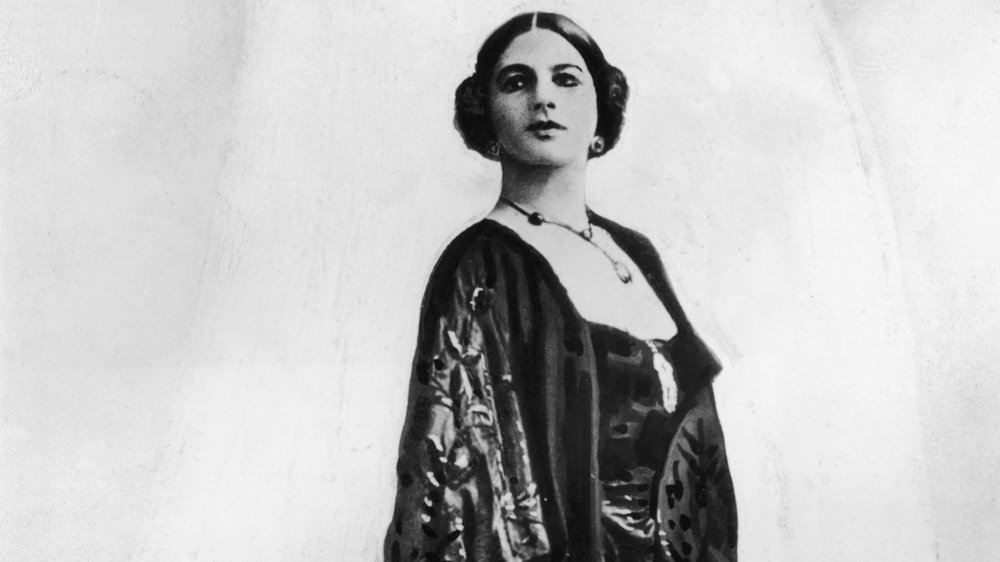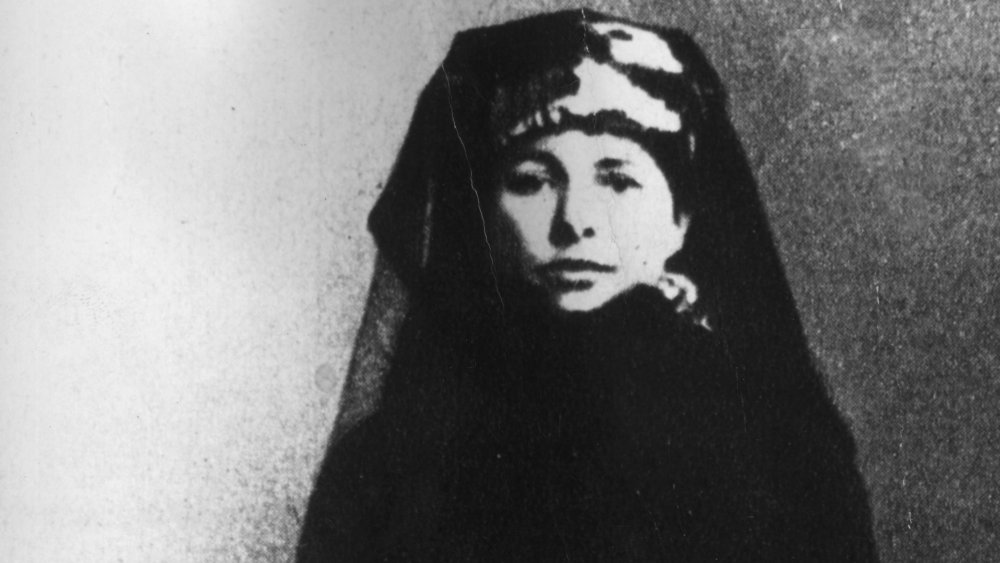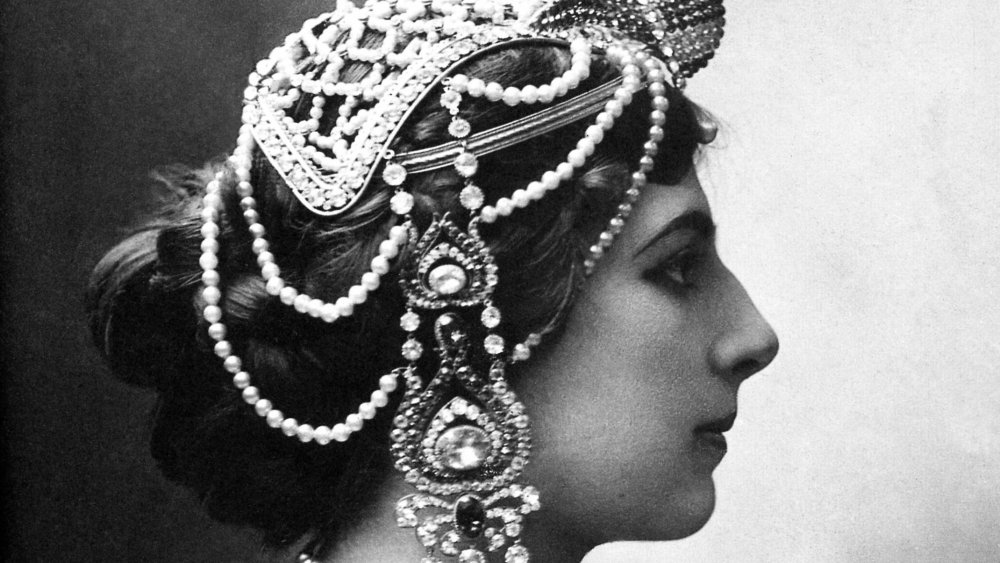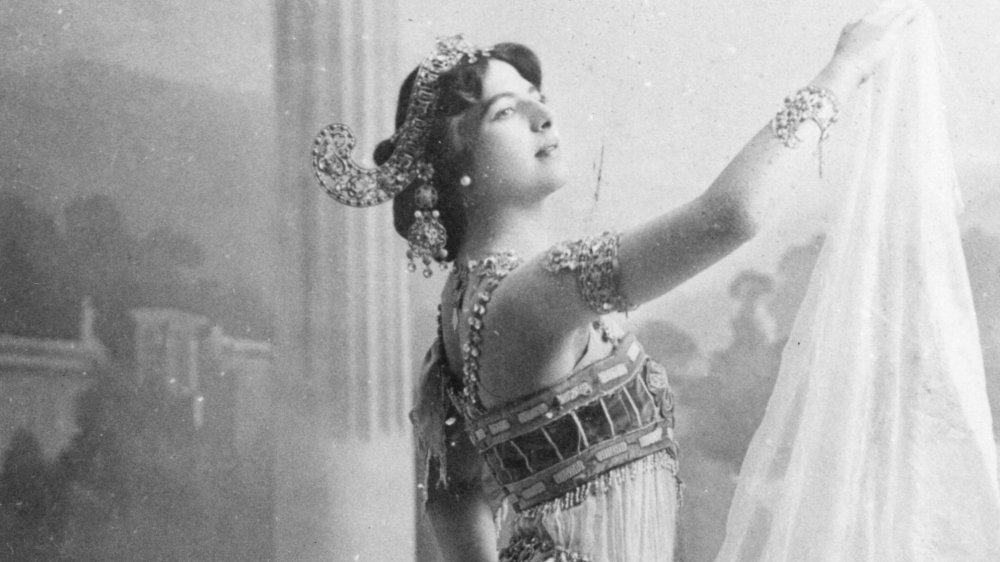The Crazy Real-Life Story Of Mata Hari
Beautiful, provocative, and dangerous, Mata Hari has gone down in history as the femme fatale du jour of World War I. It was a story made for Hollywood, and Greta Garbo's portrayal of Mata Hari in her namesake 1931 film further cemented her dangerous temptress status in the cultural consciousness.
Mata Hari doubtless checks many of the boxes of the classic archetype. She was exotic and alluring, a promiscuous dancer, a courtesan, a divorcee, and a seductive spy. But that isn't Hari's whole story. She was a battered wife, a grieving mother, and a romantic and at times desperate woman. Hari was also a scapegoat and a warning, her tragic story serving as an "example of what might happen if your morals were too loose," according to biographer Julie Wheelwright (via The Star). There is so much more to her tale than you ever imagined. This is the crazy real-life story of Mata Hari.
Mata Hari's father doted on her
Mata Hari wasn't always the famous seductress she was fated to become. In fact, the first dozen years of her life were comfortable but relatively unremarkable. She was born in Leeuwarden, Netherlands on August 7, 1876, to Adam and Antje Zelle, according to Biography. Her parents christened her Margaretha Geertruida Zelle, and she went by nickname "Gretha" for years before she adopted her legendary stage name, per the Guardian.
Adam Zelle was a successful hat merchant, and the family was financially well-off. Hari and her three brothers were sent to private schools and received the best education available in the Netherlands. Pat Shipman in National Geographic described Hari as an "orchid among dandelions," with dark hair and olive skin that stood out among her fair, blond-haired Dutch classmates. Hari was a bright and attractive girl, and gifted with an early prowess for both languages and the art of sexual persuasion. Mata Hari learned at an early age that her beauty and charming demeanor could entice men, especially her father, to give her what she wanted. Hari was spoiled, doted upon, and generally happy, until her life abruptly changed in 1889.
Bad investments tore Mata Hari's family apart
In 1889, when Hari was only 13, her father made a series of poor investments in oil, which ruined the family financially, per the Guardian. He was forced to declare bankruptcy. Shortly after, he left the family to be with another woman, divorcing Hari's mother and moving to Amsterdam to be with her, according to National Geographic. Hari's mother died in 1891, and Hari and her brothers were sent off to live with separate relatives.
Hari ended up first in the care of her godfather, then later an uncle, before she was sent away to study teaching at a teachers' college in Leiden, per Britannica. But school didn't seem to interest her as much as her headmaster, with whom she began having an affair in 1892. The headmaster was a married man, so after their affair was found out, Hari was expelled. With nothing else keeping her in Leiden, she moved to Hague, but the Hague didn't seem to interest her much either.
Bored, lonely, and craving excitement, Hari was intrigued by an advertisement she saw in the newspaper Het Nieuwes van den Dag in March of 1895, per Encyclopedia. An army captain named Rudolf "John" MacLeod had placed an ad (or it may have been placed by a friend as a joke) looking for "a girl of pleasant character" whom he could make his wife, and Hari decided to write to him.
Mata Hari was no butterfly
Enticed by the alluring photograph Hari sent along with her response to the ad, MacLeod invited her to meet him. MacLeod decided to marry Hari just six days after their first meeting. Their wedding was held in July of 1895. After a brief stay in Amsterdam, Hari moved with MacLeod to his station in the Dutch East Indies in 1897, reports Encyclopedia.
Per Shipman, Hari "wanted to live like a butterfly in the sun," but her life with her husband took a dark turn. MacLead was jealous and abusive, and he drank heavily. When he drank, he either beat her or cheated on her, or both. As a result of MacLeod's philandering, Hari contracted syphilis just two years into their marriage. A relative described Hari as having "passed from the hands of a caddish father into the hands of a caddish husband," according to the Guardian. MacLeod was not only a serial cheater. He could also be dangerously violent. In a letter, Hari described the time MacLeod ”came close to murdering me with the bread knife. I owe my life to a chair that fell over and which gave me time to find the door and get help,” via the Boston Globe.
According to Mashable, Hari distracted herself from her unhappy marriage by immersing herself in the local culture. She spent a good deal of time studying Indonesian dance traditions, learning skills that would serve her well later in life.
Tragedy struck Mata Hari's small children
Mata Hari's personal life took an even more tragic turn in 1899. Despite their unhappy marriage, Hari and MacLeod had two children together, a 2-year-old son named Norman-John, and daughter, Louise Jeanne, born in 1898.
In 1899, for reasons that even today remain unclear, both children fell violently ill. According to National Geographic, the cause of the illness was complications from congenital syphilis the children had contracted from their parents. Hari called the base doctor to the house, but, while attempting to treat the syphilis with mercury, he administered far too high a dose for the young children. They resulting mercury poisoning severely weakened Louise Jeanne and killed Norman-John.
However, according to the Washington Post, another version of the story claims that the children were sickened after their nanny mysteriously poisoned them. In any case, Mata Hari had tragically lost her son, and the news of their child's death caused a scandal around the base. As a result, MacLeod was demoted and assigned a posting at a smaller, less prestigious base for the remainder of his time in the Dutch East Indies.
Mata Hari eventually escaped to Paris
With one child dead, her marriage continued to crumble, and in 1902, Hari couldn't take it anymore. She separated from MacLeod shortly after the couple returned to the Netherlands, according to Mashable.
Although Hari was granted legal custody of her daughter, MacLeod refused to make child support payments. With no money and no way to support her young daughter, Hari felt she had no choice but to leave her daughter in the care of MacLeod. The decision tormented her. She described herself in letters as depressed and "yearning for Nonnie ... I can get by well here in Paris ... but I am abstaining from everything for my child (so far). In the event that I am certain of never again being able to have her with me as her mother, then I shall care no longer and shall cast everything aside," via the Guardian.
She decided to move to Paris in 1903, claiming she "thought all women who ran away from their husbands went there," according to the New York Times. With no money and few options to support herself, Hari took on a series of odd jobs, including teaching German, giving piano lessons, and sitting as an artist's model, according to History Extra.
Mata Hari's dancing skyrocketed her to stardom
Any so-called respectable career, it seemed, did not pay enough for Hari to support herself financially. But while sitting as an artist's model, she had made some useful connections in Paris' art world. According to Biography, she had an affair with a French diplomat, who convinced her to take advantage of the theatrical "Oriental" craze that was skyrocketing in popularity across Europe.
Putting both her sexual allure and background in Indonesian dance to use, Hari took to the stage. She began first as a circus horse rider, performing under the name Lady MacLeod, to the great displeasure of her ex-husband's family, per the National Archives.
In 1905, she began dancing under the stage name "Mata Hari," which translates to "eye of the day" in Malay, per Britannica. She performed an enticing strip tease, dancing nearly nude except for an elaborately decorated breast plate and jewelry. She spun an exotic back story, billing herself as a Javanese princess. She claimed to be the daughter of a Javanese Buddhist priest and a Dutch woman who was born in a Hindu temple. To make her story more believable, she often performed draped in gauzy shawls, with statues of Hindu gods serving as her props, per Encyclopedia. Her olive complexion and dark coloring helped sell the fantasy. Her risque performances were an instant hit. For the next decade, Hari received invitations to perform to sold-out audiences all over Europe.
World War I changed Mata Hari's life
By the time World War I began in 1914, Hari's career was in decline. As the saying goes, imitation is the greatest form of flattery, and by 1910, younger, more beautiful, more skilled imitators had all but run Hari off the stage. She performed her last show in 1915, according to History Extra.
Hari, however, was still beautiful, still very well-known, and still had a knack for attracting male attention. She became a courtesan, taking on a series of rich and powerful lovers. Her sexual conquests included high ranking military officers, influential politicians, and even royalty, per the New York Times.
At first, Hari was largely unaffected by the war. While others were suffering food and coal shortages, Hari's lifestyle hadn't much changed. She was accustomed to travelling and living lavishly, and she continued to do so. Her extravagant style raised some ire, and even suspicion, which was exacerbated by her apparently lax loyalties. Hari seduced her lovers indiscriminately, sleeping with men from a variety of nationalities, including French, Russian, Dutch, Spanish, Swiss, and German. In a later interview, Hari would claim that her weakness was men in uniforms. According to an unsealed M15 file, when Hari was "faced with her acquaintances with officers of all ranks and all nations, she replied that she loved all officers, and would rather have as her lover a poor officer than a rich banker," via the Star.
A Russian pilot was the love of Mata Hari's life
Mata Hari had many lovers, but none were as important to her as Vadim Maslov, a Russian pilot serving with the French army. Although he was nearly half her age, Hari fell deeply in love with him, declaring Maslov "possibly the only love of my life," according to Encyclopedia.
Hari was living in Berlin at the start of the war. She was expelled by the Germans, but not before they seized her money and valuables. However, they later reconsidered. Thinking Mata Hari might be of some use to them, they offered her 20,000 francs to become a spy. She accepted the money, but there is little evidence that Hari actually passed them useful information. Per Shipman, she viewed the money as repayment for the items the Germans had taken when she was forced from the country.
With money now in her pocket, Mata Hari continued to travel. Hari met Maslov when she visited Paris is 1916, per the Independent, and quickly became infatuated with the young captain. The couple made plans to marry. However, while flying a mission over Germany in the summer of 1916, Maslov's plane was shot down. He survived, but he was exposed to phosgene gas, which left him almost blind. Maslov was sent to a hospital near the front to recover. Hari was desperate to see him. But, to be granted access to the front, she had to obtain permission from the Deuxième Bureau, the French military intelligence agency, per Vintage News.
Mata Hari agreed to spy for France
The French secret service had also taken notice of Mata Hari. In 1916, when Hari approached the Deuxième Bureau, the French intelligence officers struck up a deal. She could see her lover Maslov, but only if she agreed to spy for the French, according to History Extra. The French sweetened the deal with the offer of 1 million francs, and Hari agreed, seemingly unconcerned that she had already agreed to pass information to the German side. French intelligence, however, already suspected Hari of being a double agent. According to an MI5 intelligence report, Hari was "suspected of having been to France on important missions for the Germans," via the Guardian.
The head of the Deuxième Bureau, Georges Ladoux, ordered Mata Hari to return to the Hague and await further instruction. All the while, French authorities continued to gather intelligence on her, hoping to catch her in the act of betrayal, according to Encyclopedia.
Hari eventually received orders to go to Germany by way of Spain, but she was stopped by British officials en route. Confused by the real name on her passport, they had mistaken her for another German spy named Clara Benedix and brought her to London for questioning, according to National Geographic. Hari confessed to the British that she was working under Ladoux's orders, but when they contacted him, he responded with only: "Understand nothing. Send Mata Hari back to Spain." British authorities complied, and Hari continued to Madrid.
Mata Hari was 'a born spy'
French authorities continued to monitor Mata Hari for definitive proof of her duplicity. Ladoux finally received the confirmation he had been waiting for in late 1916. Hari seduced a German intelligence attaché named Major Arnold Kalle, under the pretense of gathering information for the French. She passed along pieces of French gossip to Kalle in exchange for what turned out to be equally useless information on German activity.
Kalle already suspected Hari was working for France. According to the Independent, he transmitted radio messages detailing Mata Hari's whereabouts to Berlin, intentionally using a code that he knew French intelligence had already broken. In the messages, Kalle used Hari's code-name, H-21. One intercepted message read: "Agent H21 just arrived in Madrid; has managed to get recruited by the French, but was turned back by the British and is now requesting instructions and money," per Encyclopedia.
French intelligence intercepted the message and identified Mata Hari as the spy code-named H-21. French official felt they had all the evidence they needed to prove Hari's role as a double agent. In his reports, French investigator Captain Pierre Bouchardon described her as "speaking five languages, with lovers in every capital of Europe, moving in any number of different worlds ... Mata Hari could justly claim to be an international woman ... a born spy," via Encyclopedia. When Hari returned to Paris in February of 1917, French authorities arrested her on charges of espionage. She was imprisoned and held for five months at St. Lazare Prison in Paris.
'I have always lived for love and pleasure'
Mata Hari's trial took place over two days in July of 1917, per Britannica. She was brought before a closed-door military tribunal on eight counts of espionage. The prosecution accused her of revealing information to Germany that resulted in the deaths of 50,000 French soldiers.
Per Encyclopedia, French authorities confronted her with evidence that she had accepted 20,000 francs from the Germans. Hari admitted to taking the money, but insisted that her loyalties had always laid with the French. Hari vehemently denied allegations that she was a German spy, exclaiming, "A courtesan, I admit it. A spy, never ... I have always lived for love and pleasure," according to Biography. Few witnesses came forward, and no evidence was admitted that proved Hari had passed any military secrets to the enemy. In fact, according to biographer Julie Wheelwright (via The Star), the evidence suggests that Hari "really did not pass on anything that you couldn't find in the local newspapers in Spain."
Despite the flimsy evidence, the court was unconvinced. In their judgement, the court described Hari as "one of the greatest spies of the century, responsible for the deaths of tens of thousands of soldiers," via the Guardian. Deliberations lasted a mere forty-five minutes before the French military tribunal declared Mata Hari guilty of espionage and sentenced her to death by firing squad.
'Must I wear that?'
Mata Hari tried to appeal her sentence, but her attempts failed. At just past 5:30 am on the morning of October 15, 1917, Hari was driven to the barracks of Caserne de Vincennes. She was walked out to the field where the 12 soldiers that would be her executioners were lined up and waiting, per Encyclopedia. Hari's lawyer, nuns, the prison doctor, and a regiment of soldiers served as witnesses, according to National Geographic.
Hari was smartly dressed, wearing a blue dress, a veil, and gloves, but she rejected the option of a blindfold. "Must I wear that?" she asked the soldiers who offered the white cloth before refusing it, according to the Washington Post. She accepted her fate with grace. Per the Independent, one eyewitness account claimed that "she displayed unprecedented courage, with a small smile on her lips, just like in the days of her great triumphs on stage."
Her sentence was read, and Hari faced the firing squad. Although this story has been debunked as a myth, stories have a way of sticking to Hari, and the myth still persists: The story goes that, in her final moments, Mata Hari turned to the soldiers and blew them one last kiss before they open fired.
